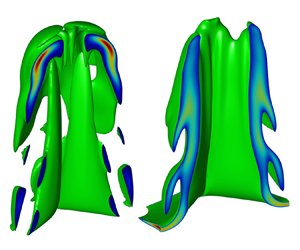No CrossRef data available.
Article contents
Self-generated magnetic field in three-dimensional ablative Rayleigh–Taylor instability
Published online by Cambridge University Press: 04 December 2024
Abstract

The self-generated magnetic field in three-dimensional (3-D) single-mode ablative Rayleigh–Taylor instability (ARTI) relevant to the acceleration phase of a direct-drive inertial confinement fusion (ICF) implosion is investigated. It is found that stronger magnetic fields up to a few thousand teslas can be generated by 3-D ARTI rather than by its two-dimensional (2-D) counterpart. The Nernst effects significantly alter the magnetic field convection and amplify the magnetic fields. The magnetic field of thousands of teslas yields the Hall parameter of the order of unity, leading to profound magnetized heat flux modification. While the magnetic field significantly accelerates the bubble growth in the short-wavelength 2-D modes through modifying the heat fluxes, the magnetic field mostly accelerates the spike growth but has little influence on the bubble growth in 3-D ARTI. The accelerated growth of spikes in 3-D ARTI is expected to enhance material mixing and degrade ICF implosion performance. This work is focused on a regime relevant to direct-drive ICF parameters at the National Ignition Facility, and it also covers a range of key parameters that are relevant to other ICF designs and hydrodynamic/astrophysical scenarios.
JFM classification
- Type
- JFM Papers
- Information
- Copyright
- © The Author(s), 2024. Published by Cambridge University Press



